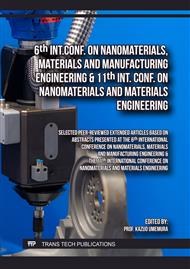p.39
p.45
p.51
p.59
p.67
p.75
p.81
p.87
p.95
Direct Integration of Iron Oxide Nanoparticles on Bacterial Cellulose for Dye Degradation in Water
Abstract:
Nanocomposites derived from biomaterials are crucial in advancing sustainable and innovative functional materials for diverse applications, including environmental remediation and wastewater treatment. In this paper, we report the fabrication of a magnetic composite derived from magnetic iron oxide nanoparticles (MIONPs) and bacterial cellulose (BC) for the photocatalytic degradation of organic pollutants in water. The magnetic films were fabricated by in situ co-precipitation of MIONPs into the BC matrix. Fourier transform infrared spectroscopy revealed the presence of Fe-O vibrations in the nanocomposite. Scanning electron microscopy and energy-dispersive X-ray spectroscopy further confirmed the presence of MIONPs on the surface of the bacterial cellulose, indicating the successful integration of MIONPs into the matrix. X-ray diffraction pattern of the nanocomposite exhibited the crystalline features of the MIONPs. The photodegradation capacity of the magnetic BC films was evaluated using methylene blue (MB) as a model organic pollutant. Results revealed the photodegradation efficiencies of approximately 68% and 73% after 120 mins of irradiation under ambient and ultraviolet (UV) light, respectively. Early onset of dye degradation saturation was also observed for samples exposed to ambient light condition. No significant changes in the optical absorption of the dye when treated with BC only with and without illumination, suggesting that the photocatalytic effect is primarily due to the MIONPs. This work presents a promising strategy for utilizing biological resources such as bacterial cellulose as a hybrid material for environmental and other advanced applications.
Info:
Periodical:
Pages:
67-73
Citation:
Online since:
March 2025
Price:
Сopyright:
© 2025 Trans Tech Publications Ltd. All Rights Reserved
Share:
Citation:



